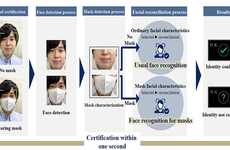
The 'Faceless Recognition System' Identifies Concealed Faces
References: arxiv.org & thenextweb
The 'Faceless Recognition System' from researchers at the Max Planck Institute is based on facial recognition software, but takes the concept of facial recognition to an oxymoronic level. That's because the facial recognition software in the Faceless Recognition System is able to identify people in images in which their face is partially or even fully obscured.
The Faceless Recognition System is not entirely faceless, as it requires at least one picture of a person's face in order to identify faceless images. Still, its statistical results when analyzing images are staggering. When given just one unobscured image of a person's face, the algorithm can correctly identify an obscured image 69.6 percent of the time, and with 10 images, that percentage rises to 91.5.
The researchers who created the system warn that such a technique, which may already be in operation online in a similar form, "should raise concern" for privacy advocates.
The Faceless Recognition System is not entirely faceless, as it requires at least one picture of a person's face in order to identify faceless images. Still, its statistical results when analyzing images are staggering. When given just one unobscured image of a person's face, the algorithm can correctly identify an obscured image 69.6 percent of the time, and with 10 images, that percentage rises to 91.5.
The researchers who created the system warn that such a technique, which may already be in operation online in a similar form, "should raise concern" for privacy advocates.
Trend Themes
1. Faceless Recognition - The development of the 'Faceless Recognition System' highlights the trend of identifying concealed faces through advanced facial recognition software.
2. Obfuscated Image Analysis - The use of image analysis algorithms to accurately identify obscured images is a growing trend in the field of recognition technology.
3. Privacy Concerns - The privacy concerns raised by the implementation of faceless recognition systems highlight the need for new regulations and ethical considerations.
Industry Implications
1. Technology - The technology industry can leverage faceless recognition systems to enhance security measures and improve identification processes.
2. Security - The security industry can explore the applications of obfuscated image analysis to identify concealed faces and prevent potential threats.
3. Data Protection - The data protection industry can address the privacy concerns surrounding faceless recognition systems by developing strategies and protocols to safeguard personal information.
2.9
Score
Popularity
Activity
Freshness























